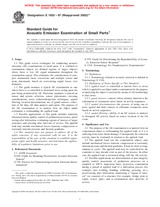We need your consent to use the individual data so that you can see information about your interests, among other things. Click "OK" to give your consent.
ASTM E1932-97(2002)e1
Standard Guide for Acoustic Emission Examination of Small Parts (Includes all amendments And changes 8/16/2017).
Automatically translated name:
Standard Guide for Acoustic Emission Examination of Small Parts
STANDARD published on 10.12.1997
The information about the standard:
Designation standards: ASTM E1932-97(2002)e1
Note: WITHDRAWN
Publication date standards: 10.12.1997
SKU: NS-43640
The number of pages: 5
Approximate weight : 15 g (0.03 lbs)
Country: American technical standard
Category: Technical standards ASTM
Annotation of standard text ASTM E1932-97(2002)e1 :
Keywords:
acoustic emission, mateirals characterization, nondestructive evaluation, nondestructive testing, production quality control, small parts, ICS Number Code 17.140.01 (Acoustic measurements and noise abatement in general)
Additional information
| 1. Scope | ||||||||||
|
1.1 This guide covers techniques for conducting acoustic emission (AE) examinations of small parts. It is confined to test objects (or defined regions of larger objects) where there is low AE signal attenuation throughout the test region. This eliminates the consideration of complex attenuation factor corrections and multiple sensor and array placements based on overcoming signal losses over distances. 1.2 The guide assumes a typical AE examination as one where there is a controlled or measured stress acting upon the part being monitored by AE. Particular emphasis is placed on sensor and system selection, sensor placements, stressing considerations, noise reduction/rejection techniques, spatial filtering, location determination, use of guard sensors, collection of AE data, AE data analysis and report. The purpose of the AE examination is to analyze how an object under evaluation is withstanding the applied load. 1.3 Possible applications of this guide includes materials characterization, quality control of production processes, proof testing after fabrication, evaluating regions of interest of larger structures and retesting after intervals of service. The applied load may include mechanical forces (tension, compression or torsional) internal pressure and thermal gradients. This standard does not purport to address all of the safety concerns, if any, associated with its use. It is the responsibility of the user of this standard to establish appropriate safety and health practices and determine the applicability of regulatory limitations prior to use. |
||||||||||
| 2. Referenced Documents | ||||||||||
|
We recommend:
Technical standards updating
Do you want to make sure you use only the valid technical standards?
We can offer you a solution which will provide you a monthly overview concerning the updating of standards which you use.
Would you like to know more? Look at this page.




 Cookies
Cookies
